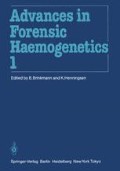Zusammenfassung
Die Standardisierung des Paternity Index basiert auf den Irrtumswahrscheinlichkeiten nach Schulte Mönting und Walter. Durch die vorgeschlagene Standardisierung wird neben der vollen Information der Blutgruppenbefunde auch der Untersuchungsumfang berücksichtigt. Die Interpretation des rechnerischen Ergebnisses erfolgt durch verbale Prädikate. Neben der wesentlichen Tatsache, daß der Untersuchungsumfang berücksichtigt wird, ist ein Hauptvorteil dieses Vorgehens, daß das rechnerische Ergebnis in die Gerichtsentscheidung nur durch den PI und sein verbales Prädikat eingeht und nicht durch mitunter relativ hohe Prozentwerte, die von Laien falsch verstanden werden können. Beim gegenwärtigen Stand reicht bei den meisten Fälle die alleinige Verwendung der Ausschließungschance für Nichtväter (A) aus. Bei einem Untersuchungsumfang von 25 Systemen einschließlich HLA wird bei über 90 % der Mutter-Kind-Paare ein Wert von A = 99,73 % erreicht oder überschritten, was den Beweis der Vaterschaft eines Mannes allein durch die Tatsache des Nicht-Ausschlusses bedeutet.
Summary
The standardization of the paternity index (PI. X/Y) is based on the probabilities of error according to Schulte Mönting and Walter. By using the suggested standardization, the test volume is taken into account including the full information of the blood group findings. The interpretation of the mathematical result is given by verbal predicates.Besides the essential fact that the test volume is taken into account, the most important advantage of this procedure is that the mathematical result is included in the court decision only by the PI and its verbal predicate and not by sometimes relatively high percentages, that may be misunderstood by laymen. At the present stage, the use of the chance of exclusion for non-fathers (A) alone is sufficient in most cases. At a test volume of 25 systems including HLA, more than 90 % of the mother/child pairs reach or exceed a value of A = 99,73 %, indicating proof of paternity by the fact of non-exclusion of a man alone.
Access this chapter
Tax calculation will be finalised at checkout
Purchases are for personal use only
Preview
Unable to display preview. Download preview PDF.
Author information
Authors and Affiliations
Editor information
Editors and Affiliations
Rights and permissions
Copyright information
© 1986 Springer-Verlag Berlin Heidelberg
About this paper
Cite this paper
Martin, W. (1986). The Standardized Paternity Index for the Statistical Evaluation of Blood Group Findings in Paternity Testing. In: Brinkmann, B., Henningsen, K. (eds) 11th Congress of the Society for Forensic Haemogenetics (Gesellschaft für forensische Blutgruppenkunde e.V.). Advances in Forensic Haemogenetics, vol 1. Springer, Berlin, Heidelberg. https://doi.org/10.1007/978-3-642-71150-3_101
Download citation
DOI: https://doi.org/10.1007/978-3-642-71150-3_101
Publisher Name: Springer, Berlin, Heidelberg
Print ISBN: 978-3-540-16500-2
Online ISBN: 978-3-642-71150-3
eBook Packages: Springer Book Archive

